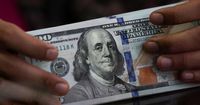The dollar took a significant hit on April 11, 2025, as it slumped to a three-year low against the euro, reflecting waning confidence in the U.S. economy. Investors are increasingly opting for safe havens, including the Swiss franc and gold, both of which saw notable gains amid the turmoil.
On this day, the dollar dropped as much as 1.2% to 0.81405 Swiss franc, marking its lowest point since January 2015. The currency also slid 1.1% to 142.88 yen, the weakest it has been since September 30, 2022. Meanwhile, the euro surged as much as 1.7% to $1.13855, a level not seen since February 2022. This dramatic shift in currency values is indicative of a broader trend where investors are losing faith in U.S. assets.
According to a report by Reuters, the dollar index, which measures the currency against six major counterparts, sagged as much as 1.2%, temporarily dipping below the 100 level for the first time since July 2023. "I'm deeply concerned about a lack of confidence among investors in the U.S. now," said Nomura strategist Naka Matsuzawa. "It's a no confidence vote from not just the equity market but also Treasury market participants in the Trump administration and its policies."
The recent downturn in the dollar's value coincides with President Donald Trump's abrupt pause on higher tariff rates on various trading partners, announced just days earlier. However, this relief was short-lived, as the administration quickly reversed course, escalating duties on Chinese imports to an effective 145% rate. This back-and-forth approach has left many investors bewildered and further eroded trust in U.S. economic policies.
As a result of these developments, the Swiss franc has emerged as a key beneficiary of the market turbulence. On the same day, a spokesperson for the Swiss National Bank (SNB) declined to comment on the strength of the franc, which has reached a fresh decade high. The likelihood of a return to negative interest rate policy in Switzerland is increasing if the franc continues to strengthen, raising concerns about the potential impact on the Swiss economy.
Gold, too, has seen a remarkable rise, recording a new all-time peak of $3,219.84 per ounce. Investors are flocking to the precious metal as a safe haven amid fears of a declining dollar and uncertainty in the markets. This surge in gold prices underscores the growing preference for tangible assets over volatile currencies.
Market analysts suggest that the recent shifts indicate a broader trend of investors seeking refuge in safe havens during times of economic uncertainty. Brent Donnelly, president of Spectra Markets, commented, "I think we are entering a pure 'sell USD' regime. Rate differentials are losing their sway over the USD for the first time in my life."
The volatility in the markets has not only affected currencies but also impacted U.S. Treasury yields. The benchmark 10-year Treasury yield climbed nearly 10 basis points early on April 11, reaching 4.488%. This spike in yields marks the biggest weekly jump since 2001, further highlighting the changing dynamics in the financial landscape.
As the world watches these developments unfold, the implications for international trade and finance are significant. The dollar's decline against other currencies may lead to adjustments in trade relationships and economic strategies globally. With key policymakers and industry leaders closely monitoring the situation, the next steps taken by the U.S. administration will be crucial in shaping the future of the economy.
In summary, the events of April 11, 2025, reflect a pivotal moment for the U.S. dollar and the broader economic climate. As investors reassess their strategies in light of the recent turmoil, the trend towards safe havens like the Swiss franc and gold is likely to continue. The uncertainty surrounding U.S. economic policies and the ongoing geopolitical tensions only add to the complexity of the current financial environment.






